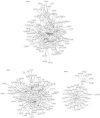Predicting novel genomic regions linked to genetic disorders using GWAS and chromosome conformation data - a case study of schizophrenia
- PMID: 31784692
- PMCID: PMC6884554
- DOI: 10.1038/s41598-019-54514-2
Predicting novel genomic regions linked to genetic disorders using GWAS and chromosome conformation data - a case study of schizophrenia
Abstract
Genome-wide association studies identified numerous loci harbouring single nucleotide polymorphisms (SNPs) associated with various human diseases, although the causal role of many of them remains unknown. In this paper, we postulate that co-location and shared biological function of novel genes with genes known to associate with a specific phenotype make them potential candidates linked to the same phenotype ("guilt-by-proxy"). We propose a novel network-based approach for predicting candidate genes/genomic regions utilising the knowledge of the 3D architecture of the human genome and GWAS data. As a case study we used a well-studied polygenic disorder ‒ schizophrenia ‒ for which we compiled a comprehensive dataset of SNPs. Our approach revealed 634 novel regions covering ~398 Mb of the human genome and harbouring ~9000 genes. Using various network measures and enrichment analysis, we identified subsets of genes and investigated the plausibility of these genes/regions having an association with schizophrenia using literature search and bioinformatics resources. We identified several genes/regions with previously reported associations with schizophrenia, thus providing proof-of-concept, as well as novel candidates with no prior known associations. This approach has the potential to identify novel genes/genomic regions linked to other polygenic disorders and provide means of aggregating genes/SNPs for further investigation.
Conflict of interest statement
The authors declare no competing interests.
Figures
References
Publication types
MeSH terms
LinkOut - more resources
Full Text Sources
Medical
Research Materials
Miscellaneous




